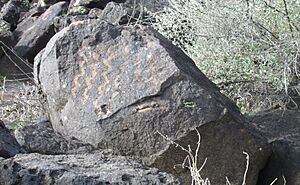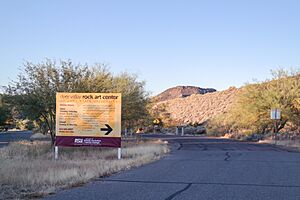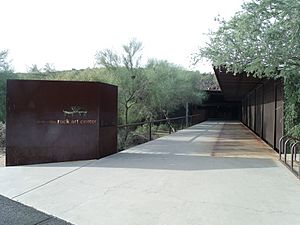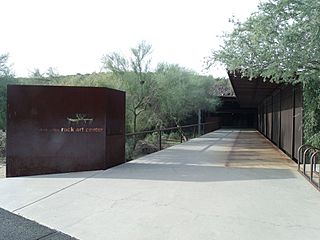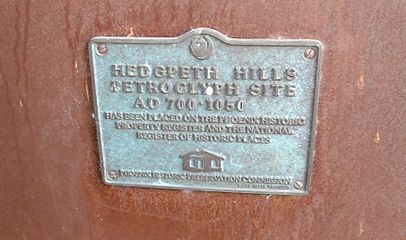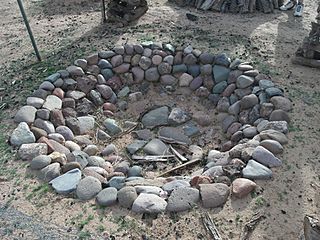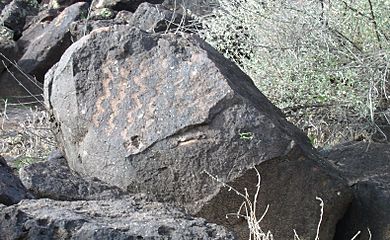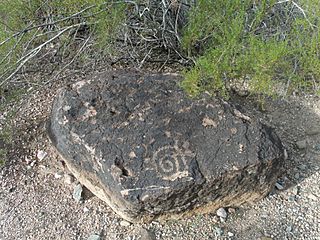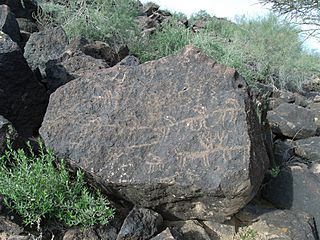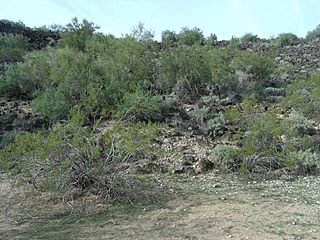Deer Valley Petroglyph Preserve facts for kids
Quick facts for kids |
|
|
Deer Valley Petroglyph Preserve
|
|
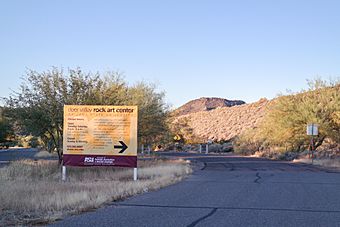
The entrance in 2013
|
|
| Location | 3711 West Deer Valley Drive Phoenix, Arizona |
|---|---|
| Area | 47 acres (19 ha) |
| NRHP reference No. | 84000718 |
| Added to NRHP | February 16, 1984 |
The Deer Valley Petroglyph Preserve is a special place in Phoenix, Arizona. It used to be called the Deer Valley Rock Art Center. This preserve covers 47 acres of land. Here, you can see more than 1,500 ancient rock carvings, called petroglyphs. These carvings were made by three different groups of people: the Hohokam, Patayan, and Archaic people.
These amazing petroglyphs are found on 500 basalt boulders. They are very old, ranging from 500 to 5,000 years old! The preserve is listed on the National Register of Historic Places. It is also one of the Phoenix Points of Pride. Arizona State University (ASU) helps run the preserve and its museum.
Contents
Discovering Ancient Art
In 1980, a big project began before a dam was built nearby. The US Army Corps of Engineers hired experts to study the land. They wanted to find any important historical sites. The Museum of Northern Arizona led this important archaeological work.
During their three-month study, they found many interesting things. The most exciting discovery was 1,571 petroglyphs on 579 boulders! They also found places where people made tools. There were old cooking pits and even a small ancient house. These findings help us understand how people lived long ago.
The experts learned that the petroglyphs came from three main ancient cultures. The Western Archaic people made some of the oldest carvings, from about 5000 BC to 300 AD. The Hohokam people created art from 300 to 1450 AD. Finally, the Patayan people left their marks from about 700 to 1550 AD.
People in the past often stopped here briefly. They would make tools, do special rituals, or just rest. The preserve was officially created to protect these important historical treasures. Today, Arizona State University helps manage this amazing site.
What Are Petroglyphs?
The petroglyphs are the most famous things found at the preserve. They are carvings made on rocks. These carvings are between 500 and 5,000 years old. Rock art like these petroglyphs is very important. It shows us how ancient people lived and what was important to them. Many other things from the past have disappeared. But these rock carvings have lasted for thousands of years!
People used these petroglyphs for different religious and cultural activities. This was especially true during the Hohokam Preclassic era, from about 700 to 1100 AD. You can find many other petroglyph sites around Phoenix. This shows that the Hohokam people had strong connections to the land.
Arizona State University's Role
Arizona State University (ASU) helps run the Deer Valley Petroglyph Preserve. Since 1994, ASU has worked hard to protect this special place. They also help people learn about it every day. The university offers many ways to explore the site. You can learn about the native cultures through books, guided tours, and talks.
Working with the Community
ASU works with several groups to make the preserve a great place for everyone.
- Canyon Records: This company makes and shares Native American music. Since 2017, they have partnered with ASU. They help create learning materials for the preserve. They share Native American art, music, and stories.
- Act One: This group helps schools bring students to cultural places. The preserve offers special days for school field trips. It also takes part in a program that gives free museum admission.
- Archaeology Southwest: This organization studies the past and helps protect historical sites. Their magazine is sold at the preserve. They also give talks about archaeology and research.
- Arizona Master Naturalist: These are skilled volunteers who know a lot about nature. They help visitors learn about the preserve's plants, animals, and history.
- Osher Lifelong Learning Institute: This program offers classes for adults aged 50 and up. They have special talks at the preserve. These classes cover topics like anthropology and archaeology.
- Girl Scouts of the USA: The preserve works with the Girl Scouts. They offer workshops where girls can earn badges. These workshops teach about archaeology, protecting nature, and desert wildlife.
What You Can See at the Museum
ASU has created many exhibits at the preserve. These exhibits help visitors learn even more. The main exhibit is called "Leaving Marks: The Rock Art and Archaeology of Deer Valley." It tells the detailed story of the site. It also explains why it is so important to the area. This exhibit was made possible with help from the Arizona Humanities Council.
Other exhibits have been shown at the preserve too. These include "Legacy of Landscapes: The Art and Archaeology of Perry Mesa" and "One World, Many Voices: The Artistry of Canyon Records."
The Preserve Building
The museum building at the Deer Valley Petroglyph Preserve is very interesting. It was designed by architect Will Bruder and landscape architect Christy Ten Eyck. It was built in 1994. The building has a unique shape, like a boomerang. This shape is meant to show how it connects the city of Phoenix to the peaceful preserve.
The building has spaces for exhibits, teaching, and research. It is a main gathering spot at the preserve. Thousands of people visit it every year. People who love architecture also come from all over the world to see its special design.
Gallery
Hohokam petroglyphs and other items at the Deer Valley Petroglyph Preserve
-
A petroglyph with a spiral carved into it
-
The Hedgpeth Hills and Sonoran Desert viewed from the center
See also
- Phoenix Historic Property Register




